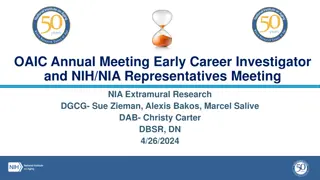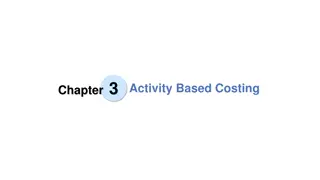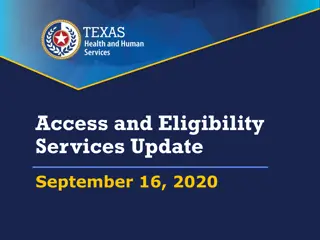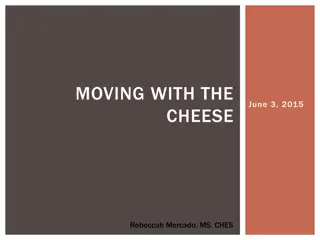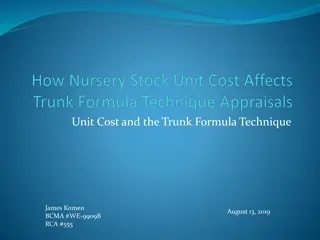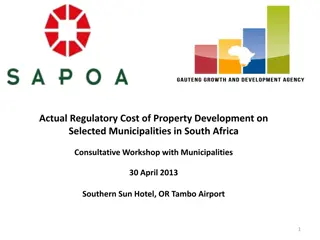Understanding Unit Cost Methodology Training for Area Agencies on Aging
This training provides an overview of cost allocation principles and the Unit Cost Methodology (UCM) through video sessions and practical applications using UCM spreadsheets. It covers federal regulations, the operation of UCM, and the importance of cost allocation in federally funded programs. The content aims to help participants understand and apply these concepts to ensure fair cost recovery in service delivery.
Download Presentation

Please find below an Image/Link to download the presentation.
The content on the website is provided AS IS for your information and personal use only. It may not be sold, licensed, or shared on other websites without obtaining consent from the author. Download presentation by click this link. If you encounter any issues during the download, it is possible that the publisher has removed the file from their server.
E N D
Presentation Transcript
Florida Association of Area Agencies on Aging ___________________________________________________________ Unit Cost Methodology Training ___________________________________________________________
Format of Training Format of Training Overview of cost allocation principles & the Unit Cost Methodology Two separate video sessions Application & practices using the UCM spreadsheets Addressing previously submitted questions, as well as new ones Training developed with committee of AAA CFOs
Understand the federal regulations underlying the process What Do We What Do We Want to Want to Accomplish? Accomplish? Understand the operation of the Unit Cost Methodology Answer questions on the UCM and the service costing/funding process
Why Are We Doing This? Why Are We Doing This? Older American s Act of 1965 Spawned national network for organization & delivery of services to the elderly Major source of funding services delivered by local providers Federal regulations apply to federal funding, even if passed through to states, counties, and Area Agencies
Cost allocation is based on the premise that each federally funded program should only bear its appropriate share of indirect costs based on the benefits received or derived by each program Indirect Cost Indirect Cost Allocation Allocation Benefits received or derived according to an objective metric, not according to subjective value Feds will pay their fair share, but no more 2 CFR 200 is guidebook for cost recovery
Federal 2 CFR Part 200 Federal 2 CFR Part 200 2 CFR Part 200 UNIFORM ADMINISTRATIVE REQUIREMENTS, COST PRINCIPLES, AND AUDIT REQUIREMENTS FOR FEDERAL AWARDS Formerly A-87, Cost Principles for State & Local Government Prescribes allowable and unallowable costs, cost principles Standardization of costing procedures Reasonableness the guiding principle
UNIT COST METHODOLOGY UNIT COST METHODOLOGY Purpose is to develop a Unit Rate for most services based on service cost. Developed in 1995, revised as elder service network has evolved Based on Federal cost allocation policies and industry standards
Cost Treatment Cost Treatment To be considered Allowable, the costs must be: Documented Necessary Consistently treated Reasonable Net of applicable credits
Allowable & Unallowable Allowable & Unallowable Costs Costs A complete list and understanding of costs that are allowable and non-allowable can be found in 2 CFR Part 200. Examples of Allowable Costs Wages PR Taxes Benefits (common benefits) Depreciation (for Capitalized items) Dep n for Land & Bldg. only as Indirect Insurance Maintenance & Repair Equipment (Not Capitalized) Meetings & Conferences. (w/out Entertainment)
Allowable & Unallowable Allowable & Unallowable Costs Costs Examples of Allowable Costs (Continued) Supplies Membership / Subscriptions Security Printing Marketing / Outreach Rent Training / Education Travel Utilities
Allowable & Unallowable Costs Allowable & Unallowable Costs Examples of Unallowable Costs Contingency Reserve Contributions Entertainment Fines & Penalties Fundraising Costs Bad Debt Cost for Idle or Unused Facilities Other Contract Losses Taxes
Direct & Indirect Costs Direct & Indirect Costs Direct Costs Directly identifiable with specific services. On the UCM, Direct Costs are placed directly under the service for which the cost is reasonable, ordinary, and necessary. Direct costs are assigned.
Direct & Indirect Costs Direct & Indirect Costs Indirect Costs Costs that have been incurred for common objectives but cannot be readily identified with a particular service. In the UCM, there are two places for which Indirect Costs are placed: Management & General Cost Pool and the Facilities & Maintenance Cost Pool. Indirect costs are allocated.
Pro Prospective vs spective vs Retro Retrospective UCM spective UCM Prospective based on budgeted (forecasted costs) Use CIRTS information to project service units If not first year, use actual prior year units in prospective UCM Project salary increases (formula or manually) and part-year salaries Retrospective based on actual costs Use actual service units and actual costs Ignore salary increase column Service Cost Report has served as a retro UCM
UCM Spreadsheet UCM Spreadsheet Tips & Tricks Tips & Tricks Make Make two copies of the UCM spreadsheet file Don t override Don t override formulas (Salary increase & fringes exceptions) Pare down Pare down spreadsheets by hiding columns and rows (but not the end ones) Don t duplicate If service is the same but different funding sources, don t need to create more than one service column Display either all agency costs or just DOEA funded costs (recommend all) Display If just DOEA, do not include all overhead & admin costs!
UCM Cost Pools UCM Cost Pools Management and General Cost Pool (People): Overhead costs not related to facilities and maintenance such as CEO Salary, CFO Salary, Consultants and other costs that support the entire organization rather than specific services. Automatically allocates after all costs have been entered into the Services, Non-DOEA Services, and both Cost Pools. This allocation is formula driven and allocated proportionately to all services based on Total Cost per service.
UCM Cost Pools UCM Cost Pools Facilities and Maintenance Cost Pool (Facilities): Automatically allocates to service by square footage. Total agency square footage and the allocation of that square footage to services is entered onto the UCM If facility square footage is not available, use number of staff to allocate costs among services
Basic Principle: CONSISTENCY Allocation Allocation Methods Methods The same methodology should be applied over time to provide a consistent review of costs allocated in rate development.
Allocation Methods Allocation Methods Personnel Allocation Worksheet: Wages: o For staff that is being directly assigned to various services, there should be a reasonable, logical, and consistent method for determining the distribution. Such methods may include time sheets or time studies. o Certain positions that work only under one service are easy, as 100% of their time would be placed under one service. o Consideration should be made for upper management such as Executive Directors, CFOs, COOs, or CIOs to be placed in the Management & General Cost Pool so that they are allocated automatically to all services that are provided. Time accounting has always been the most important element of accurate cost allocation & accounting
Allocation Methods Allocation Methods Unit Cost Worksheet: Fringe PR Taxes and Benefits will automatically be allocated proportionately based on total Salaries within each service. Communications and Postage, Insurance Generally, assigned directly to the Management & General Cost Pool. Utilities, Space Cost (Rent), Insurance Generally, assigned directly to the Facilities Maintenance Cost Pool. Equipment Non Capitalized equipment. May be specific to a service or may benefit the entire agency and be placed in Facilities and Maintenance Cost Pool.
Allocation Methods Allocation Methods Unit Cost Worksheet continued: Education/Training, Printing & Supplies, and Advertising These expenses may be specific to a service or services which should be assigned directly to the service(s) or may benefit the entire agency. If the cost is of benefit to multiple services or the entire agency, it should be placed under the Management & General Cost Pool.
Allocation Methods Allocation Methods Unit Cost Worksheet continued: Professional Fees / Legal / Audit Legal & Audit - Generally are for the entire agency benefit or requirement and should be placed under the Management & General Cost Pool. o oProfessional Fees Expenses such as consultants or professionals contracted for specific purposes such as a Nutritionist, IT Consultants, or Accounting/Bookkeeping professionals. Not to be confused with Subcontractors. The allocation depends on the nature of the service. A Nutritionist may be divided between Congregate Meals, Home Delivered Meals, or Nutrition Education. The contracted accounting/booking firm may be assigned directly to The Management and General Cost Pool.
Allocation Methods Allocation Methods Unit Cost Worksheet continued: Subcontractors For the use of the UCM, subcontractors should be thought of as those that are either providing service directly or the product for the service and for whom a unit of service can be directly attributed to. Examples include: o Caterers, o Home Health Companies, o Mental Health Organizations that provide Counseling o Medical Supply Companies o Housing Improvement Contractors These are generally service specific and should be assigned directly to a service or services. Total Cost for the subcontractor is determined by the subcontracted rate multiplied by the anticipated number of units to be delivered, for Subcontractors that are contracted with a unit rate.
Allocation Methods Allocation Methods Unit Cost Worksheet: Continued: Program Supplies Costs unique and necessary for specific services and are generally assigned directly to services. Depreciation This expense is for capitalized equipment or Real Property. oDepreciation for buildings or facilities can only be placed under the Facilities and Maintenance Cost Pool. oDepreciation for equipment specifically used for a service can be assigned directly to that service. oDepreciation for equipment purchased that benefits the entire agency should generally be placed in the Facilities and Maintenance Cost Pool.
Allocation Methods Allocation Methods Unit Cost Worksheet: Continued: Food & Food Supplies This is not to be confused with the cost of meals contracted with a caterer. These costs are generally related to Entertainment, are unallowable, and should be placed under Fundraising & Unallowable Costs. Other Expenses that will not fit into any other line. However, it is not to be a catch all. The costs here should be no more than the lesser of $20,000 or 1% of the Total Budget. If greater than this threshold, a separate document should be submitted detailing the costs included on this line.
Subcontractor Allowance Subcontractor Allowance Subcontractor Allowance: In recognition that it may take a bit more Management & General costs to manage subcontractor contracts, this allowance provides the opportunity to increase the proportionate allocation of those services that contain subcontractor expense. The subcontract amount (subject to limitations below) should be assigned directly to the benefiting service(s). Maximum of $25,000 per subcontract (not per subcontractor). For subcontracts that include more than one service, the $25,000 allowance should be allocated proportionately between the services. Contract limit of $25k is so the cost allocation won t be distorted.
Other UCM Requirements Other UCM Requirements Square Footage Occupied: As previously mentioned, the Facilities and Maintenance Cost Pool is allocated by square footage. Total agency square footage must be entered, and the total square footage must be allocated in a reasonable manner to all the services or Non-DOEA funded programs. If not possible, use number of staff occupying space as allocation basis.
Other UCM Requirements Other UCM Requirements Units: Enter the anticipated number of units of service to be provided for each service. Should have a foundational basis not a complete guess. Looking at service units provided historically should help guide the anticipated number of units that will be provided.
Costs should be allocated to benefiting service, regardless of the funding source Funding considerations handled on the Support Budget Worksheet. Distinction Distinction between cost between cost allocation & allocation & funding funding Difference between rate (SBW) and cost (UCM). Cost allocation mechanics should not be influenced by funding considerations
Support Budget Worksheet Support Budget Worksheet The last of the three worksheets. Up to this point, the cost for delivering one unit of service has been developed, regardless of how the service is funded. This worksheet introduces how contracted rates may differ from the cost calculated on the previous worksheet. Factors that can cause contracted rate to differ from the actual cost for delivering one unit of service: o Funding received from non-DOEA sources for a service or services o Funding received from NSIP o Match o Co-Pay (CCE & ADI only) o Program Income
Support Budget Worksheet Support Budget Worksheet It is possible to have different rates for the same service across different Programs due to specific program requitements. For Example: The rate for Home Delivered Meals would be different in OAA C2 than in LSP because of Match Requirements. The rate for In-Home Respite would be different in OAA 3E than in ADI because of Co-Pay requirements in ADI.
Support Budget Worksheet Support Budget Worksheet Should you be funded through more than one program for the same service, it is recommended to handle this in one of two ways: 1. Copy the entire workbook and save it under a different name such as UCM-OAA and UCM-ADI 2. Copy the last worksheet into a new worksheet (or tab) and change the name of the tab. By doing this, you can much more easily use the last worksheet for each program without great confusion.
In our next session, we will use the UCM to develop unit costs for a sample provider agency. Unit Cost Unit Cost Methodology Methodology QUESTIONS ?







